The MSI Prestige 14 Evo Review: Testing The Waters Of Tiger Lake
by Brett Howse on December 17, 2020 10:00 AM EST- Posted in
- Laptops
- Intel
- MSI
- Tiger Lake
- Notebook
Display Analysis
As the name suggests, the MSI Prestige 14 Evo features a 14-inch display, and MSI has gone with the more standard 1920x1080 IPS panel, meaning a 16:9 aspect ratio. That is somewhat disappointing, as competing laptops have started to transition to taller displays in the 16:10 and 3:2 range.
The laptop offers no touch support either, so this is as traditional of a clamshell Ultrabook as you can get. Some may not like touch, but for a wider audience, having a feature and not using it is better than not having it at all.
 Sub-pixel arrangement. The haze is the matte coating on the display.
Sub-pixel arrangement. The haze is the matte coating on the display.
The 1920x1080 resolution in this screen size means the laptop offers 157 pixels-per-inch in terms of display density. There is always a tradeoff for density versus battery life, and although 157 is pretty far from what you would consider a high DPI panel, it still works well in this form factor. Out of the box, Windows sets this to 150% scaling, although you can of course adjust if you want more real estate. 125% seems to work pretty well. There is no UHD display option, but as we have seen in other devices which offer UHD, the hit to battery life is significant, so sticking with a more traditional 1920x1080 resolution still makes sense.
The display targets sRGB, and although some competing devices may offer P3 or Adobe RGB gamut support, the lack of a system-wide color management system in Windows still unfortunately means sRGB is better for most people. If you use professional applications that can correctly manage color, the MSI Prestige is likely not for you, but for the average consumer using content that is likely over 99% of the time targeting sRGB, MSI has made the right choice here.
To see how the MSI Prestige 14 Evo fares in terms of color accuracy and contrast, we have run it through a custom workflow in Portrait Display’s Calman suite, using the X-Rite i1Display Pro colorimeter for brightness and contrast measurements, and the X-Rite i1Pro 2 spectrophotometer for color accuracy readings.
Brightness and Contrast
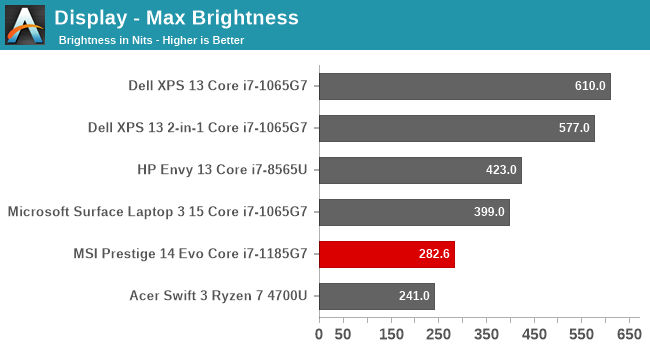
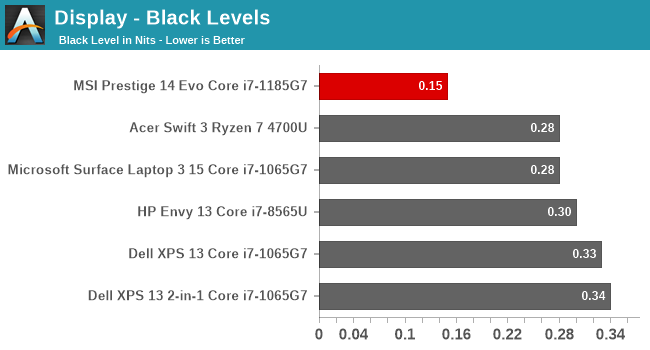
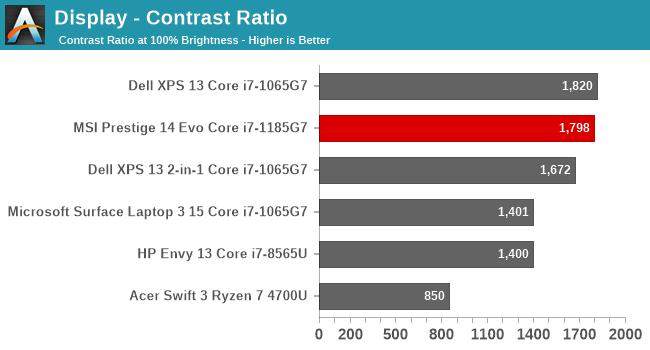
The Prestige 14 gets off to a good start in terms of display contrast, almost hitting 1800:1. The panel offers excellent black levels which help it achieve this result. It does not get overly bright though, not even hitting 300 nits at 100% brightness, and would likely struggle outdoors because of that. It does get very dim though for use in a dark room with the display going all the way down to 5 nits.
Grayscale

MSI has done a very good job on the default color profile for this laptop, with the grayscale averaging under the 3.0 level that we’d consider to be a good display. There are a couple of peaks slightly over, but nothing too dramatic. The color balance across the gray range is very consistent, with blue dropping slightly compared to red and green, but overall still doing very well.
Gamut
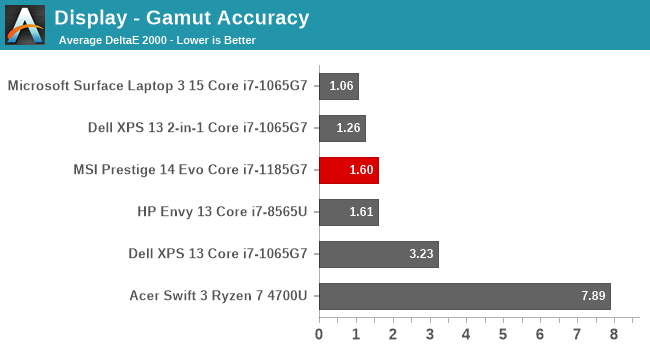
The good news continues when looking at the sRGB gamut coverage. The laptop is able to hit all of the major color points for primary and secondary colors with very little error.
Saturation
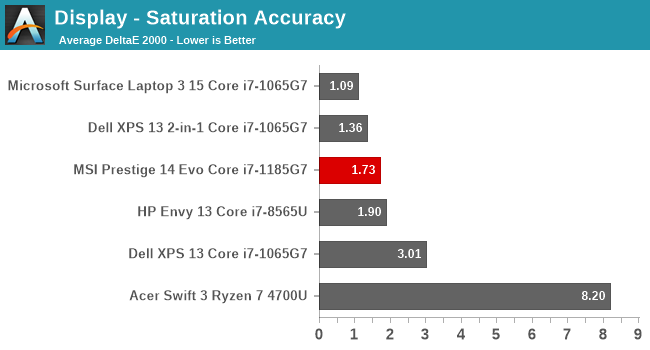
The saturation sweep does the same color targets as the gamut test, but across the entire range from 0% to 100% brightness on each primary and secondary color, tested at 4-bit intervals. None of the colors show any real error rates above the 3.0 mark, with most well under across the entire range. Clearly, MSI has done their homework and calibrated the display at the factor to achieve these levels of accuracy. There is no ICC profile included as the error correction is being done in hardware.
Gretag Macbeth

While the previous tests focus on primary and secondary colors, the Gretag Macbeth tests a much wider range of colors, including the important skin tones. Once again, the MSI Prestige 14 performs very well here, with only a couple of individual colors above the 3.0 error level, and only just. MSI has done a great job calibrating this display.
Colorchecker
While the previous graphs show error rates, the final image is the colorchecker swatch, which shows the target color on the bottom, and the achieved color by the display on the top. This gives you a better relative look at the error rate. Again, it shows the accuracy of this display.
Display Conclusion
Although the MSI Prestige 14 Evo is a mostly standard 1920x1080 16:9 display, and it just targets sRGB, MSI has done the added work to calibrate the display at the factory, which vastly improves its accuracy. Some devices use an ICC profile to fix the calibration through software, but ICC profiles can be a challenge especially if the application ignores them, so doing this through hardware is a better solution. The combination of high contrast and high accuracy make this one of the better displays available in this category.















63 Comments
View All Comments
Spunjji - Friday, December 18, 2020 - link
It's a fair point. The 4000 series isn't last-gen until the newer devices are out. It still competes pretty well, though.lucasdclopes - Thursday, December 17, 2020 - link
AMD's CPUs beating Intel's CPU.Intel's IGP beating AMD's IGP
What a time to be alive...
Speedfriend - Thursday, December 17, 2020 - link
And Apples CPU and GPU smashing both. On its first attempt...zodiacfml - Thursday, December 17, 2020 - link
Not really, AMD's high end mobile APUs can compete or beat the M1 on heavy workloads. to be fair, m1 is Apple's entry level designKPOM - Thursday, December 17, 2020 - link
The point is that the M1 draws so little power, Apple removed the fan from the MacBook Air and still tripled its multi-core performance.senttoschool - Thursday, December 17, 2020 - link
M1 smashes AMD in any workload that is not Cinbench R23 Multithread. There.Otherwise, the M1 is superior is just about every way including power, temperature, battery life, no throttling on battery, GPU, encoding and decoding, SSD speeds, and of course, single thread.
whatthe123 - Thursday, December 17, 2020 - link
that's already been tested and proven untrue. it is far superior in efficiency, but loses when more than 4 cores/8 threads are utilized and when memory systems are comparable. either its artificially capped to keep power down or the design's efficiency curve falls off at higher frequencies because it absolutely does not outperform x86 8C/16T parts. it's also on a cutting edge node competing with 7nm/10nm parts yet its basically the same single thread performance as zen 3, so not exactly blowing anyone away with just raw architecture.lemurbutton - Friday, December 18, 2020 - link
It is true. The M1 is faster than the 4900HS in multithread Geekbench which tests a variety of workloads and it's significantly faster in single core. And unlike AMD processors, it does not throttle when it's on battery and it has 2x more battery life in general.So no. AMD's very best mobile processors can't touch the M1.
Kuhar - Friday, December 18, 2020 - link
Don`t bother with delusional apple fanboys.Sailor23M - Friday, December 18, 2020 - link
@senttoschool Well put, TY.